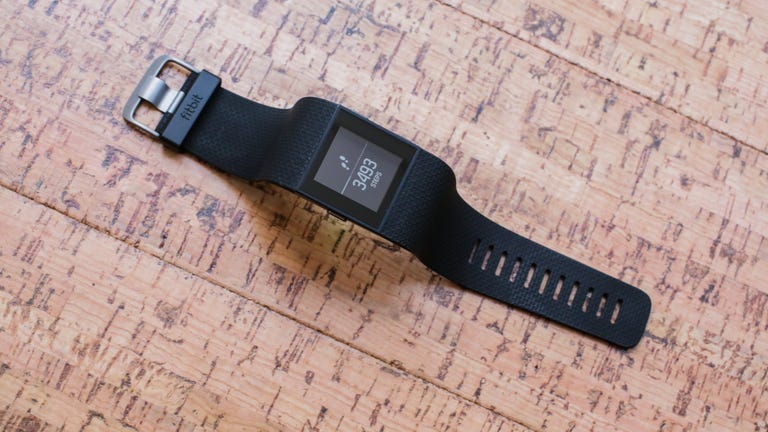 Why You Can Trust CNET
Why You Can Trust CNET Fitbit Surge review: Fitbit's top-end GPS watch and fitness tracker feels like it needs an update
The Fitbit Surge offers all-day fitness tracking, a built-in optical heart-rate sensor, smartphone notifications and GPS to track multiple sports, but the design feels old and clunky.
The Fitbit Surge was one of the first watches to include all-day fitness tracking, GPS, smartphone notifications and an optical heart-rate sensor. But a lot has changed since it was first announced in 2014. The competition has since caught up to Fitbit and in some instances has even surpassed it.
The Good
The Bad
The Bottom Line
We now have multifunction products like the Apple Watch, Samsung Gear Fit 2 and various Android Wear watches. Meanwhile, fitness companies like Garmin, Polar and TomTom have also started to include built-in heart-rate sensors and smartphone notifications in their GPS watches.
While the $250 (£200, AU$400) Surge isn't as distinct as it was two years ago, it's still a good buy for active consumers due to the superior Fitbit software, which is one of the easiest to use, has the largest social base and syncs with a variety of other services. The Surge, however, isn't ideal for more serious athletes. If you don't need GPS, you're also better off getting one of Fitbit's other trackers. Here's why:
It's bigger and bulkier than other watches
Calling the Surge big would be an understatement. The watch is enormous. The grayscale touchscreen is also dull to look at and can be difficult to see outdoors. While I do like that the screen is always on, I wish Fitbit would give us more appealing watch faces. There are only four to choose from and none of them offer anything besides the time and date. If you want to see your steps or any other metric, you have to swipe to the next screen.
The big design does allow for a larger battery, though. The Surge will last up to seven days, or up to 10 hours with an active GPS signal. I typically saw around four days, but your time will vary depending on how frequently you use the GPS.
You can't wear it in the shower
Looking for a fitness tracker to swim with? This isn't it. Fitbit doesn't recommend swimming or showering with the Surge, which is odd considering the watch has been tested to withstand up to 5 ATM (50 meters) of water pressure.
Heart rate data isn't accurate
The optical heart-rate sensor on the back of the watch isn't very good. It was the most accurate when measuring resting heart rate, but there were still random spikes (which you can view below). It had a lot of problems measuring heart rate during easy runs and hard workouts. When compared to a Polar H7 chest strap, the Surge tended to fluctuate by around 20 to 30 beats per minute, which is worse than other sensors, such as those used in the Garmin Forerunner 235 and Vivoactive HR.
You can view the heart rate data in the chart below (give it a minute to load):
It only shows some notifications
Fitbit describes the Surge has a superwatch, but that couldn't be further from the truth. While it can display call information and text messages when connected to an iPhone or Android phone, there's no support for email or third-party apps. Regardless what Fitbit says, this isn't a smartwatch.
Other watches to consider
The Surge is a good multisport watch for tracking a variety of activities, in addition to steps, distance, calories burned, floors climbed and sleep. The GPS was off slightly in my tests (about 0.1 mile), but testing in New York City tends to deliver inconsistent results. It should fare better in more rural areas.
Regardless, I don't recommend the Surge for more serious athletes. Garmin's Vivosmart HR offers a better bang for your buck. It has longer battery life, a waterproof design and better heart-rate tracking. All of this for the same $250 price.
If you aren't interested in GPS, I recommend the Fitbit Blaze. It offers a more appealing and slimmer design, but can still track multiple activities and heart rate, along with displaying notifications for calls and text messages. Plus, you can use your phone's GPS alongside the Blaze for tracking runs.
If you want to be a part of the Fitbit ecosystem and are looking for a GPS watch, the Surge will meet your basic needs. Be warned, however, that the watch is old. Recent rumors have also suggested that we may see new Fitbit products sometime down the road, although it remains unclear if the Surge will even be part of the rumored product refresh.


